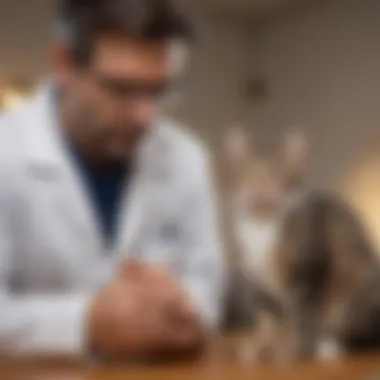Understanding Male Cat UTI Signs: A Comprehensive Guide


Intro
Urinary tract infections (UTIs) in male cats can create significant distress for both pets and their owners. Understanding the signs and symptoms of these infections is essential for early identification and treatment. This guide will explore various aspects of male cat health, focusing on UTIs. By understanding what to look for, cat owners can act swiftly, improving their pets' quality of life.
Understanding Your Pet
Breed Traits
Different cat breeds may exhibit specific traits that impact their vulnerability to UTIs. For instance, breeds like Persian or Maine Coon may have unique predispositions affecting their urinary health due to physical structure or metabolic conditions. Understanding these traits can help owners monitor their cats more effectively.
Common Temperaments
Male cats often display varied temperaments. Some might be more prone to stress or anxiety, factors that can influence their urinary health. Recognizing your cat's behavior can aid in determining if any changes relate to a potential UTI.
Special Needs
Certain males may have special needs requiring increased attention. For instance, older males often face different health challenges, including UTIs. Owners should be vigilant and aware of their pet's unique requirements for optimal health and well-being.
Pet Care Essentials
Nutrition and Feeding Guidelines
Proper nutrition plays a critical role in maintaining urinary health. A balanced diet, appropriate for the cat's age and health status, helps prevent UTIs. Foods designed specifically for urinary health can also be beneficial.
Grooming Tips and Techniques
Grooming is not just about aesthetics; it can influence overall health. Regular grooming allows owners to check for unusual symptoms or behaviors that may indicate a UTI. This practice can lead to early detection.
Health and Wellness
Routine veterinary check-ups are vital as they provide opportunities to monitor urinary health. Vaccines and preventative care can help reduce the risks associated with urinary tract infections.
Training and Behavior
Basic Training Techniques
Training your male cat can promote a stress-free environment. A calm, well-adjusted cat is less likely to develop health problems, including UTIs. Basic commands and positive reinforcement methods are effective for encouraging good behavior.
Behavioral Problems and Solutions
If a cat exhibits sudden behavioral changes, it might point to an underlying health issue. Disinterest in litter boxes or frequent trips without urination may indicate a UTI. Identifying and addressing these problems can prevent escalation.
Mental Stimulation Activities
Providing mental stimulation is essential for a male cat’s overall well-being. Engaging toys and activities help reduce stress and anxiety, factors which can exacerbate urinary health problems.
Engaging with Your Pet
Interactive Games and Toys
Interactive playtime strengthens bonds between cats and their owners. It encourages physical activity, which can help maintain a healthy weight. A healthy weight is crucial for minimizing the risk of UTIs.
Safe Outdoor Activities
Outdoor exploration can also promote health but should be done cautiously. Ensure that outdoor activities are safe and controlled to prevent accidents or stress that may affect urinary health.
Family-Friendly Pet Interactions
Encouraging positive interactions among family members and the male cat creates a supportive environment. This environment can significantly contribute to the cat's emotional well-being, further influencing its physical health.


Pet Adoption and Integration
Choosing the Right Pet for Your Lifestyle
When considering adopting a male cat, it’s essential to match their needs with your lifestyle. Consider aspects such as activity level, care requirements, and potential health concerns, including UTIs.
Preparing Your Home for a New Pet
Establishing a safe, welcoming environment is crucial for a successful introduction. Make sure that litter boxes are accessible and that the cat has quiet spaces to retreat if needed.
Tips for Smooth Prolusion
Introduce new pets slowly to reduce stress. Monitor interactions among household members and existing pets to ensure a smooth transition.
Proper understanding of your male cat's health needs is vital. Timely detection of urinary tract infections can prevent more significant health issues down the line.
Intro to Male Cat UTIs
Understanding urinary tract infections (UTIs) in male cats is vital for every cat owner. UTIs can lead to severe discomfort and serious health complications if not addressed promptly. Recognizing the signs and symptoms can guide pet owners to seek veterinary assistance. This early intervention can ultimately save the cat from unnecessary suffering.
What are Urinary Tract Infections?
Urinary tract infections occur when bacteria invade the urinary system. This system includes the bladder, urethra, and sometimes the kidneys. In male cats, UTIs can lead to painful urination and may show up as frequent trips to the litter box. The presence of bacteria in urine often results in inflammation, causing the cat additional pain. Symptoms can sometimes mimic other health problems, which is why understanding the specifics of UTIs is crucial. Recognizing these nuances can greatly impact timely diagnosis and treatment.
Overview of Male Cat Health Concerns
Male cats face unique health challenges. From urinary blockages to behavioral issues, it is paramount for owners to stay informed about these potential risks. Male cats are particularly prone to developing obstructions in their urinary tract due to anatomical structures. These can cause life-threatening conditions. Regular health check-ups and observation of any changes in behaviors or routines help ensure cats remain healthy. By being aware of these concerns, pet owners can take proactive measures to support their feline companions’ health.
Recognizing the Signs of UTI in Male Cats
Recognizing the signs of urinary tract infections (UTIs) in male cats is crucial for timely intervention and treatment. UTIs can lead to discomfort, pain, and potentially severe health complications if left untreated. Being aware of symptoms allows pet owners to act quickly, ensuring their feline companions receive necessary veterinary care. This section outlines the key signs to identify a UTI in male cats, emphasizing the importance of responsiveness and vigilance in cat ownership.
Frequent Urination
Frequent urination is one of the most noticeable signs indicating a possible urinary tract infection in male cats. If a cat is urinating more often than usual, this may signify an irritation or infection in the urinary tract. Pet owners may observe their cat rushing to the litter box multiple times within a short timeframe, yet only producing a small amount of urine each time. This behavior can be distressing for both the cat and the owner, as it suggests that the cat is struggling with discomfort.
Straining to Urinate
Straining to urinate, or dysuria, is another critical indication of a UTI in male cats. It manifests as a cat exhibiting discomfort or difficulty when attempting to urinate. The cat may vocalize, crouch in the litter box for extended periods, or even paw at the area in frustration. This sign is particularly concerning, as it may signal an obstruction, which is a medical emergency. Observing this behavior necessitates immediate veterinary consultation to assess the underlying causes and prevent further complications.
Inappropriate Elimination
Inappropriate elimination refers to a cat urinating outside its designated litter box. This act can be an alarming sign for owners and often indicates underlying health issues, including UTIs. If a male cat is urinating in unusual locations, it may be a method of coping with pain or discomfort associated with the urinary tract. Monitoring changes in bathroom habits is crucial, as identifying these shifts early can lead to quicker diagnosis and treatment.
Dark or Bloody Urine
The presence of dark or bloody urine is a concerning symptom that requires immediate attention. Healthy cat urine typically appears light yellow. Dark or bloody urine often suggests the presence of blood due to inflammation or infection in the urinary tract. This condition is not only painful for the cat but also poses significant health risks. Owners must seek veterinary care right away if they notice this symptom, as further complications can arise if not addressed.
Lethargy and Behavioral Changes
Lethargy and behavioral changes are subtle yet significant signs that a male cat may be suffering from a UTI. A normally active, playful cat that suddenly shows signs of fatigue or disengagement might be experiencing discomfort or pain from an infection. Changes in appetite, grooming habits, or social behavior can also signal health concerns. Being attentive to these changes is vital for pet owners, as they often indicate a need for medical evaluation.
Recognizing these signs early can prevent further health issues and facilitate timely treatment for male cats suffering from urinary tract infections.
In summary, being alert to the signs of UTIs in male cats can make a difference in their health and quality of life. Early detection and prompt action can mitigate the complications arising from urinary tract infections.
Causes of Urinary Tract Infections in Male Cats
Understanding the causes of urinary tract infections (UTIs) in male cats is essential for pet owners. This knowledge can empower cat owners to take preventive actions and seek appropriate care when signs of illness arise. Knowing the underlying reasons can also help in recognizing serious health issues early.


Bacterial Infections
Bacterial infections are the most common cause of UTIs in male cats. Bacteria can ascend the urethra and invade the bladder, leading to infection. In many cases, Escherichia coli is the main culprit. Factors like improper hygiene, injury, or abnormal anatomy of the urinary tract may predispose cats to these infections. Timely identification and treatment are crucial to prevent complications such as kidney damage or a severe systemic infection.
Crystals and Stones
Crystals and urinary stones can significantly increase the risk of UTIs. These formations can block the urinary tract, leading to pain and inflammation. Types of crystals include struvite and calcium oxalate. Male cats are particularly susceptible because of their narrower urethras. It is vital for pet owners to monitor dietary intake, as certain foods can contribute to crystal formation. Regular veterinary check-ups can ensure that any predisposing factors are managed proactively.
Underlying Health Conditions
Various underlying health conditions may trigger urinary tract infections in male cats. Diabetes, hyperthyroidism, and kidney disease are some examples. These conditions can compromise the immune system, making it easier for infections to take hold. Awareness of any pre-existing medical issues is necessary for effective management. If a cat has a chronic health problem, it's essential to work closely with a veterinarian to develop an appropriate treatment plan.
Behavioral Factors
Behavioral factors also play a role in the development of UTIs. Stress and anxiety in cats can lead to changes in urination habits, potentially increasing the likelihood of infections. Environmental changes, such as moving to a new home or the introduction of new pets, can trigger stress responses. Pet owners should create a stable environment, and if changes occur, monitoring the cat's behavior and urination patterns is recommended. Understanding the interplay between behavior and urinary health is critical to addressing potential issues before they develop into serious conditions.
In summary, knowing the causes of UTIs in male cats is vital for their well-being. Identifying and addressing these factors can significantly lower the risk of infection and promote better urinary health.
Diagnosing UTI in Male Cats
Diagnosing a urinary tract infection (UTI) in male cats is crucial for timely treatment and effective management of their health. Recognition of symptoms is only the first step; a thorough diagnostic process confirms the presence of a UTI and rules out other health issues. Early and accurate diagnosis helps prevent complications, ensuring the cat receives appropriate care. Moreover, understanding the diagnostic methods provides pet owners with insight into what to expect during veterinary visits, thus facilitating more informed discussions with their veterinarians.
Veterinary Examination Process
The veterinary examination is the foundation of diagnosing a UTI. During this examination, the veterinarian will first take a complete history of the cat, including the observations made by the owner related to urination habits and any noticeable changes in behavior. This initial assessment is vital in creating a context for any physical examination that follows.
Next, the vet performs a physical evaluation. This often includes checking the abdomen for any signs of discomfort or abnormal swelling. Also, it can involve palpating the bladder and kidneys to assess their size and structure. The veterinarian may also observe the cat's general demeanor—whether it appears lethargic or agitated, which can offer additional clues to its overall health. Furthermore, thorough questioning about the cat's diet and water intake will assist in identifying possible causes behind the UTI.
Diagnostic Tests and Methods
The veterinarian may then recommend several diagnostic tests to pinpoint the issue effectively. These methods provide critical information that guides treatment decisions.
Urinalysis
Urinalysis is a key test in diagnosing UTIs. It involves analyzing a urine sample for signs of infection, such as the presence of bacteria or white blood cells. This method is particularly popular due to its simplicity and speed.
The key characteristic of urinalysis is its ability to not only reveal infection but also offer insights into a cat’s kidney function and overall metabolic state. One unique feature of this test is that it can detect crystals, which may indicate predisposition to future urinary issues.
However, while a urinalysis is beneficial, there are limitations. It may not indicate the specific type of bacteria involved, making follow-up culture necessary.
Urine Culture
Urine culture is another essential diagnostic tool for UTIs. This method involves growing bacteria from the urine sample in a lab to identify the specific pathogen causing the infection.
The key characteristic of urine culture is its precision. Unlike urinalysis, which can only suggest the presence of bacteria, urine culture pinpoint the exact type. This is highly beneficial for tailoring antibiotic therapy effectively.
A unique feature of urine culture is its ability to detect antibiotic resistance, which can guide treatment decisions in cases of recurrent infections. However, urine culture generally takes longer than urinalysis and requires more logistical coordination.
Ultrasound Imaging
Ultrasound imaging is a non-invasive method that allows veterinarians to visualize the urinary tract and surrounding structures. It is especially valuable in complicated cases where other diagnostic methods do not yield clear results.
The key characteristic of ultrasound is its ability to provide real-time images that reveal abnormalities in the urinary system, such as stones or tumors, often associated with UTIs. Its unique feature is the lack of radiation, making it a safe option for cats.
One disadvantage of ultrasound is that it requires skilled personnel for accurate interpretation, and not all veterinary clinics have this capability on-site. Thus, it could require referral to a specialized veterinary facility for evaluation.
Utilizing these diagnostic methods effectively allows veterinarians to confirm a UTI diagnosis and tailor a treatment plan suited to the individual cat's needs.
Treatment Options for UTI in Male Cats


Urinary tract infections (UTIs) in male cats call for prompt action. These infections can lead to severe health complications if left untreated. Thus, understanding the treatment options is crucial for pet owners. Addressing UTIs effectively can improve the health of your cat and prevent recurrent issues. This section explores different treatments available, helping pet owners make informed decisions.
Antibiotic Therapy
Antibiotic therapy is a primary approach to treating UTIs in male cats. When a veterinarian diagnoses a UTI, specific antibiotics will be prescribed based on the type of bacteria involved. It is vital for the pet owner to adhere strictly to the vet's instructions regarding dosage and duration of the treatment. Stopping antibiotics too early can lead to drug-resistant bacteria, complicating future treatments.
Signs of improvement usually appear within a few days, but it is essential to continue therapy for the entire prescribed period. Some commonly used antibiotics include Amoxicillin and Clavamox.
Dietary Management
Diet plays a significant role in managing UTIs. A balanced diet can prevent the formation of bladder stones and crystals, which often contribute to UTIs. Some cat food brands formulate products specifically designed to promote urinary health, containing a proper balance of nutrients. These formulas can help dilute the urine, making it less conducive for bacteria to thrive.
In addition to changing the food, increasing water intake can dilute urine. Wet cat food is often recommended for cats that do not drink enough water. This additional moisture can help flush out the urinary tract.
Surgical Interventions
In some complicated cases, surgical intervention may be necessary. If a male cat has developed urinary blockages due to stone formation or anatomical abnormalities, surgery can provide a solution. Procedures such as cystotomy, where the bladder is opened surgically, can allow for the removal of stones or debris.
Surgical options should be considered only after careful consultation with a veterinarian. Recovery time and post-operative care may vary depending on the extent of the procedure, so pet owners must be prepared for extra care during recovery.
It's essential to discuss any treatment plan comprehensively with a veterinarian, as they can provide tailored recommendations based on your cat's specific needs and health history.
Understanding these treatment options empowers cat owners to take decisive action against UTIs, ensuring the wellbeing of their feline companions.
Preventing Future UTIs in Male Cats
Preventing urinary tract infections (UTIs) in male cats is essential for their overall health and well-being. A UTI can not only cause discomfort but may also lead to severe complications if left untreated. Therefore, taking proactive measures can significantly reduce the risk of recurrence. Understanding the contributing factors and implementing effective prevention strategies protect your feline companion from potential health issues.
Hydration Strategies
Hydration plays a crucial role in maintaining urinary health in male cats. Adequate water intake helps dilute urine, reducing the concentration of harmful substances that can lead to infections. Here are some strategies to promote hydration:
- Encourage Fresh Water: Ensure that clean, fresh water is always available. Cats often prefer running water, so consider a water fountain that continually circulates water.
- Wet Food Inclusion: Adding wet food to your cat's diet can significantly enhance hydration. Many commercially available cat foods contain moisture, which can contribute to overall fluid intake.
- Flavor the Water: If your cat is hesitant to drink water, adding a bit of low-sodium chicken or beef broth can entice them. Just be mindful of sodium levels.
Regular hydration can be a key defense against UTIs, promoting overall urinary tract health.
Dietary Considerations
The diet of male cats has a direct impact on their urinary health. Certain dietary choices can help prevent the formation of crystals and stones that contribute to UTIs. Consider the following:
- Balanced Nutrition: Feed a high-quality diet that meets the specific nutritional needs of your cat. Consult with your veterinarian for recommendations tailored to your cat's life stage and health condition.
- Ph Levels in Food: Some foods are formulated to maintain an optimal pH level in your cat's urine. It is essential to choose brands that focus on urinary health.
- Restricting Certain Foods: Avoid excessive feeding of dry food, as it often has lower moisture content. Monitor your cat’s diet to prevent obesity, which can contribute to health problems.
Regular Veterinary Check-Ups
Routine veterinary visits are a fundamental aspect of preventing UTIs in male cats. Regular check-ups allow for early detection and treatment of any underlying health issues. Here are key components of veterinary visits:
- Health Monitoring: Your veterinarian can assess your cat’s overall health, checking for any changes or potential risks for UTIs.
- Urinalysis: Regular urinalysis can help to detect abnormalities in your cat’s urine, indicating potential problems before they develop into infections.
- Vaccinations and Preventive Care: Staying up-to-date with vaccinations and preventive treatments is essential for your cat’s health.
By implementing these strategies, you can effectively reduce the risks of urinary tract infections in male cats. Taking proactive steps can greatly impact their wellbeing and ensure a happier, healthier life for your feline companions.
End
Understanding urinary tract infections in male cats is essential for every pet owner. This guide illuminated critical aspects that contribute to awareness and proactive care. Recognizing symptoms early can lead to prompt veterinary attention and more effective treatments. Pet owners can significantly enhance their cats' quality of life through proper knowledge and timely actions.
Summary of Key Takeaways
- Awareness of Symptoms: Frequent urination, straining, and dark urine are signals to pay attention to.
- Bacterial and Non-Bacterial Causes: Various factors, including infections and crystals, contribute to UTIs.
- Diagnosis and Treatment: Veterinary examinations are crucial, with urinalysis and cultures being standard procedures.
- Preventive Strategies: Hydration and dietary choices play a central role in minimizing the chances of UTIs.
Final Thoughts on Male Cat Health
Cat owners must remain vigilant regarding urinary health. The knowledge gained about UTIs equips owners to recognize issues before they escalate. Regular check-ups and a keen observation of their pet’s behavior are central to maintaining their overall well-being. By understanding these health concerns, we reinforce our commitment to the welfare of our feline friends.
"An informed pet owner is the best advocate for their pet's health."
For further exploration, consider trusted resources like Wikipedia or Britannica.



